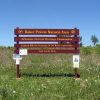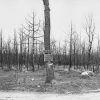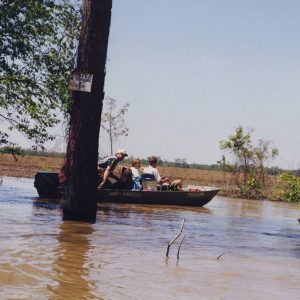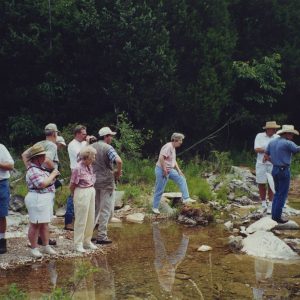calsfoundation@cals.org
Nature Conservancy of Arkansas
The Nature Conservancy of Arkansas is part of the international Nature Conservancy headquartered in Arlington, Virginia. The Nature Conservancy’s mission is to preserve the plants, animals, and natural communities that represent the diversity of life on earth by protecting the lands and waters they need to survive.
The Nature Conservancy was incorporated on October 22, 1951, in Washington DC as a nonprofit organization. The Arkansas field office, established on April 12, 1982, became the organization’s twenty-ninth state program. The Arkansas program, which opened with about 250 members and a staff of three, has grown steadily in capacity and achievement. The conservancy grew to about 6,000 members in Arkansas (the worldwide membership is about one million) and a staff of more than forty full-time and seasonal employees in nine locations.
The first director was Kay Kelley Arnold, who opened the office in Little Rock (Pulaski County). Charter board members were Charles L. Steel (chairman), H. R. “Randy” Wilbourn III, D. Allan Gates, Dr. John Simpson, Louisa Barker, John A. Cooper Jr., Tommy Goldsby, Henry Hodges, Kaneaster Hodges, David Snowden Sr., Ray Thornton, and Jim Walton. Nancy DeLamar became director in 1986. During her tenure through 2003, more than 200,000 acres in Arkansas were moved into conservation status, and she was awarded the 1993 National Wetlands Conservation Award from the U.S. Fish and Wildlife Service in recognition of the conservancy’s involvement in a 41,000-acre land exchange that created a protected corridor between the Cache River National Wildlife Refuge and the Dale Bumpers White River National Wildlife Refuge. Scott D. Simon became director after DeLamar, who now serves in a regional leadership position with the Nature Conservancy.
Arkansas’s unique geology and topography, coupled with abundant fresh water and annual rainfall, provide habitat for a rich variety of plants and animals, many found nowhere else. The conservancy engages in projects that protect thousands of species and hundreds of habitat types in Arkansas. In the Ozark Mountains ecoregion, research and protection projects in the karst ecosystem safeguard habitat for sensitive and endangered cave-dwelling creatures while protecting water quality and scenic beauty in northwest Arkansas. In south Arkansas, projects center on conservation of the remaining blackland prairies and sustainable management of native pine and hardwood forests. In the Ouachita Mountains, restoring oak woodlands and conserving river systems are the major areas of focus. In the Arkansas Delta, the Big Woods project includes conservation of bottomland hardwood forest and wetland ecosystems for migratory birds, big-river fish, black bears, and many other species. It was in the Big Woods of Arkansas that the ivory-billed woodpecker was rediscovered in 2004, giving heightened meaning to the work of the Nature Conservancy and many in the Delta over the preceding decades.
Working with a wide variety of partners and using the best available science, the Nature Conservancy identifies and conserves the landscapes and waterscapes where the richest and rarest biodiversity occurs. Major strategies include acquiring ecologically important land from willing sellers and donors; restoring degraded lands and waters; conducting prescribed burns to maintain fire-dependent habitats; promoting conservation-minded, sustainable land use practices in areas such as forestry, farming, ranching, and road construction; and researching, recording, and monitoring biodiversity.
The Nature Conservancy has played a role in conserving the following sites in Arkansas. The list below includes places where the Nature Conservancy owns property or conservation easements, and lands the Nature Conservancy has helped acquire and transfer to public agencies.
| COUNTY | SITE |
| Arkansas | Bayou Meto Conservation Area |
| Ashley | Overflow National Wildlife Refuge |
| Baxter, Stone, Searcy, Lee, Phillips | Scattered sites in Ozark-St. Francis National Forest |
| Benton | Bear Hollow Cave Preserve |
| Benton | Camden Hollow Preserve |
| Benton | Cave Springs Cave Natural Area |
| Benton & Carroll | Hobbs State Park-Natural Area |
| Boone | Baker Prairie Natural Area |
| Bradley, Drew | Warren Prairie Natural Area |
| Calhoun, Cleveland | Moro Bottoms |
| Carroll | Kings River Preserve |
| Clark | Terre Noire Natural Area |
| Clay | Stateline Sand Ponds Natural Area |
| Cleburne | Eagle Bluff Preserve |
| Cleveland | Kingsland Prairie Preserve |
| Columbia | Logoly State Park |
| Columbia, Lafayette, Nevada | Falcon Bottoms Natural Area |
| Franklin | Mulberry River Preserve |
| Franklin | Presson-Oglesby Preserve |
| Garland | Electric Island |
| Greene | Scatter Creek Wildlife Management Area |
| Greene | St. Francis Sunken Lands Wildlife Management Area |
| Hempstead | Columbus Prairie Preserve |
| Hempstead | Nacatoch Ravines Natural Area |
| Hempstead, Howard | Scattered blackland prairie sites |
| Hot Spring | Simpson Preserve on Trap Mountain |
| Howard | Stone Road Glade Natural Area |
| Howard, Polk | Cossatot River State Park-Natural Area |
| Lee | Crowley’s Ridge South |
| Little River | White Cliffs Natural Area |
| Little River, Hempstead | Grassy Lake Conservation Area |
| Lonoke | Toltec Indian Mounds State Park |
| Lonoke, Pulaski | Holland Bottoms Wildlife Management Area |
| Madison | Possum Trot Escarpment Preserve |
| Madison | Sweden Creek Falls Natural Area |
| Marion | Big-eared Bat Conservation Area |
| Marion | Brooksher Crooked Creek Preserve |
| Miller | Miller County Sandhills Natural Area |
| Monroe | Benson Creek Natural Area |
| Monroe | Pine City Natural Area |
| Monroe | White River Nature Center |
| Montgomery | Brushy Creek Preserve |
| Newton | Leatherwood Creek |
| Newton | Lyon Big Piney Creek Preserve |
| Newton | Smith Creek Preserve/Sherfield Cave |
| Ouachita | Central Sandhills Preserve |
| Phillips | Burke Crowley’s Ridge Preserve |
| Prairie | Railroad Prairie Natural Area |
| Prairie | Wattensaw Wildlife Management Area |
| Pulaski | Lorance Creek Natural Area |
| Saline | Dunnahoo Preserve |
| Saline | Dry Lost Creek Preserve |
| Sevier | Lower Cossatot River Preserve |
| Sharp | Strawberry River Preserve and Ranch |
| Stone | Blanchard Springs Caverns |
| Stone | Hell Creek Natural Area |
| Van Buren | Gulf Mountain Wildlife Management Area |
| Washington | Garrett Hollow Natural Area |
| Washington | Upper Lee Creek Preserve |
| White | Margaret M. Lightle Wilderness Area |
| Woodruff, Monroe, Jackson, Prairie, Poinsett, Arkansas | Cache River National Wildlife Refuge and scattered sites |
| Yell | Holla Bend National Wildlife Refuge |
In addition to these sites, the Nature Conservancy conducts restoration and stewardship activities at other conservation areas through contracts and management agreements with the owners. The conservancy has also provided support in several other land transactions, such as the Arkansas-Idaho Land Exchange Act of 1992 between Potlatch Corporation and the U.S. Fish and Wildlife Service and the Arkansas-Oklahoma Land Exchange Act of 1996 between the Weyerhaeuser Company and the USDA Forest Service.
For additional information:
Nature Conservancy of Arkansas. https://www.nature.org/en-us/about-us/where-we-work/united-states/arkansas/ (accessed April 30, 2025).
Nature Conservancy of Arkansas Field Office Records (BC.MSS.14.37). Butler Center for Arkansas Studies. Central Arkansas Library System, Little Rock, Arkansas. Finding aid online at https://cdm15728.contentdm.oclc.org/digital/search/searchterm/mss.14.37 (accessed April 30, 2025).
Nature Conservancy of Arkansas Newsletters. University of Arkansas Libraries, Fayetteville, Arkansas.
White, Mel. “The Business of Nature.” Arkansas Times, August 1985, pp. 56–61.
Nancy S. DeLamar
The Nature Conservancy



 Bayou DeView
Bayou DeView  Dry Lost Creek Dedication
Dry Lost Creek Dedication  Nature Conservancy Celebration
Nature Conservancy Celebration  Lisenne and Winthrop Paul Rockefeller
Lisenne and Winthrop Paul Rockefeller  Strawberry River Preserve Dedication
Strawberry River Preserve Dedication 



Comments
No comments on this entry yet.